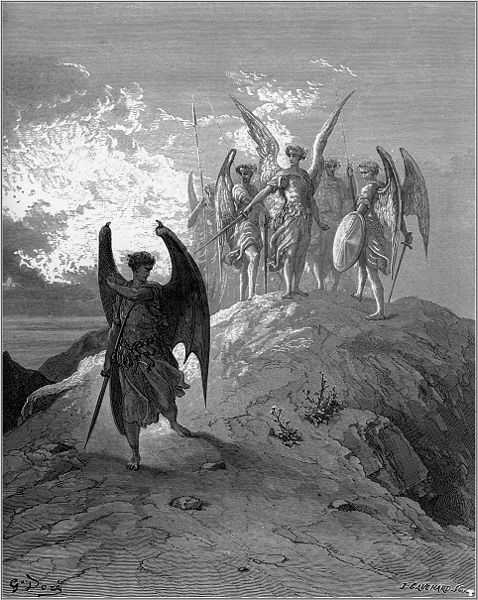
An illustration for Milton’s “Paradise Lost”
(Wikimedia Commons public domain image)
This article of mine was published yesterday, I believe, in Meridian Magazine. It was actually inspired by certain responses to a blog post here.
“Could a Loving God Allow Such Suffering?”
And this little essay, not by me, went up on the website of the Interpreter Foundation earlier today:
***
And here, as has lately been my habit, are some links to articles that were published in a prior issue of Interpreter: A Journal of Latter-day Saint Faith and Scholarship:
Abstract: The toponym Onidah, attested as the name of a hill in Alma 32:4, most plausibly derives from Hebrew ʿŏnî /ʿōnî/ʿônî (ʿonyî, “my affliction”) + yādaʿ/yēdaʿ (“he knew,” “he knows”) — i.e., “he has acknowledged my affliction” or “he knows my affliction.” This etymology finds support in the context of the Zoramite narrative in which it occurs. In view of the pejorative lexical associations of the Rameumptom, the “high” and “holy stand,” with Hebrew rām (< rwm, “high”) and haughtiness, arrogance, and pride, we see Mormon using the Rameumptom, the “high” platform for Zoramite self-exalting worship, with Onidah, the hill from which Alma and Amulek taught the Zoramite poor and humble. The latter name and Alma’s teaching from that location constituted a sign that the Lord “knew” their “affliction.” Alma devotes a significant part of his message not only extolling the spiritual value of their state of “affliction” and humiliation or compelled “humility” (ʿŏnî Exodus 3:7, 17), but teaching them how to “plant” the “word” (even Jesus Christ himself) in their hearts through prayer — the word that would grow up into a “perfect knowledge” of God — experientially “knowing” God (Alma 32:16‒36) and being known by him (cf. Alma 7:12).
Clifford P. Jones, “The Prophets Who Wrote the Book of Omni”
Abstract: The brief accounts written by Omni, Amaron, Chemish, Abinadom, and Amaleki, taken alone, don’t always inspire confidence in their righteousness. Nevertheless, when the specific words used by these men and all relevant context are taken into consideration, it’s reasonable to conclude that each of these authors of the book of Omni was a prophet of God.
Donald W. Parry, “An Approach to Isaiah Studies”
Review of Joseph M. Spencer, The Vision of All: Twenty-Five Lectures on Isaiah in Nephi’s Record (Salt Lake City: Greg Kofford Books, 2016). 318 pages. $59.95 (hardback); $29.95 paperback.
Abstract: This review makes a case, briefly, for the unmistakable presence of Jesus Christ in Isaiah’s text, which case is based on a corpus linguistic-based description of the Hebrew Bible, equivalent designations of deific names, self-identification declarations by the Lord, and more. And, importantly, one can never set aside the multiple teachings and testimonies of our modern prophets and apostles regarding Isaiah’s prophecies of Jesus Christ. Moreover, in my view, a knowledge of biblical Hebrew helps us to penetrate the very depths and heights of Isaiah’s text.
Jim Bennett, ““Somebody Wrote It:” The Book of Mormon’s Missionary Message to a 21st-Century World”
Abstract: Nathan Oman’s “Welding Another Link in Wonder’s Chain: The Task of Latter-day Saint Intellectuals in the Church’s Third Century” wisely called for “new language in which to celebrate the Restoration.” That new language can be found in understanding the power of the Book of Mormon, which is the tangible miracle at the heart of the Restoration that defies the critics. My father, Senator Robert F. Bennett, devoted his final years to arguing that the Book of Mormon’s existence is a stumbling block to those who try to dismiss it as an obvious fraud. Those who scoff at the Book of Mormon have yet to come up with a plausible secular account of its existence, and this allows the Book of Mormon to endure as the centerpiece of our missionary efforts. But rather than simply use the Book of Mormon to attempt to answer questions people are no longer asking, we need to create a missionary message that uses this sacred scripture to connect people, directly and personally, to Jesus Christ.
Noel B. Reynolds, “Rethinking Alma 36”
Abstract: While Alma 36 has long been one of the most admired examples of classical Hebrew chiasmus in the Book of Mormon, critiques in the last two decades have questioned whether, in fact, it really meets the requirements of classical biblical chiasms. The principal objections have pointed to the large sections of the chapter that are not easily included in the chiasm as outlined by John W. Welch and other proponents. Until now, this debate has not taken note of dramatic new developments in the analysis of Hebrew rhetoric over the last fifty years. The following essay turns to the discoveries made in this new approach to Hebrew rhetoric and shows that when the new “levels analysis” is incorporated into a study of Alma 36, the entire text does have a role to play in the extended chiastic structure of the chapter.
[Editor’s Note: An abbreviated version of this paper was presented at the 2019 Sperry Symposium and was included in that shortened form in the symposium volume. See Give Ear to My Words: Text and Context of Alma 36–42, edited by Kerry M. Hull, Nicholas J. Frederick, and Hank R. Smith, Religious Studies Center, 2019, 451–72. This complete and updated version is herein published by Interpreter with permission of the RSC.]
***
I’m doing a virtual fireside this evening for an online group that is based on Bainbridge Island, Washington, but that also includes members scattered across multiple other states. It’s amazing what technology has enabled us to do within just the past few years that we wouldn’t have imagined a decade or two back. It reminds me, in fact, of the article that I published in Meridian Magazine back on 6 July of this year:
“Preaching the Gospel Where We Cannot Go”
Perhaps you missed it, or you’ve forgotten it, or your conscious mind has repressed it











